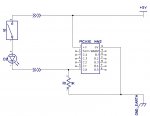Rampz
Well-known member
Phil, i found today that in the 1960's Smiths did away with almost everything except the hands and fited a AC motor and chain drive and controlled that from a control box, Seems under conservation thats not allowed any more.I can't see it's any different to removing the weights and replacing them with a coil spring and a motor...
The feeling is with the weights removed and left in the bell tower they can be reused in the future if required, removing the pendulem maybe going too far on a turret clock, alot better on a smaller clcok with lesser forces involved

